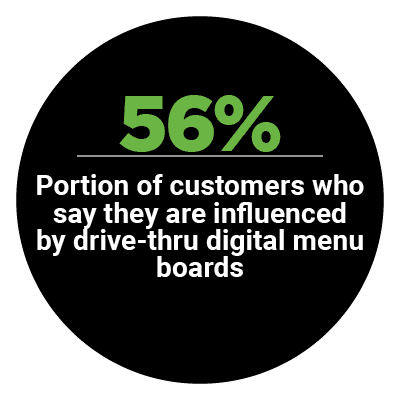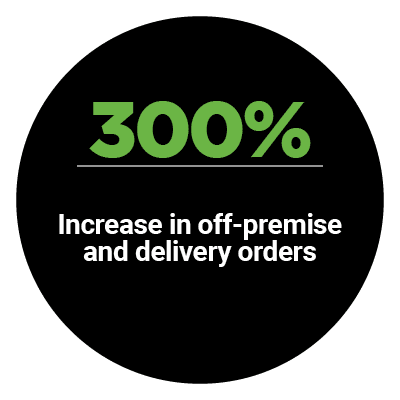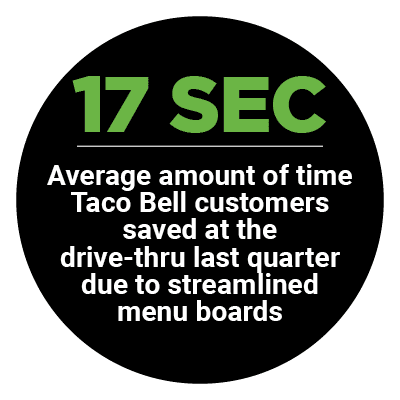
The drive-thru, which captured 70 percent of quick service restaurants’ (QSRs’) total sales in 2018, has become a critical focal point as dine-in seating areas are closed to slow the spread of the coronavirus.
To seize the opportunity to boost revenues and loyalty during this time, QSR operators are shifting their focus to digitally upgrading the drive-thru as well as other modes of off-premise ordering, such as branded mobile apps and third-party delivery aggregators. Improvements are also underway to increase speed and accuracy when ordering.
 Such investments in digital technology are expected to increase return on investment (ROI) and improve the overall customer experience. They are also designed to reduce fraud and chargebacks while shrinking labor costs with self-ordering capabilities via tablets and kiosks. The latest Order To Eat Tracker® examines how the COVID-19 pandemic is accelerating restaurants’ effort to improve efficiencies that will allow them to keep operating through the pandemic and into the future.
Such investments in digital technology are expected to increase return on investment (ROI) and improve the overall customer experience. They are also designed to reduce fraud and chargebacks while shrinking labor costs with self-ordering capabilities via tablets and kiosks. The latest Order To Eat Tracker® examines how the COVID-19 pandemic is accelerating restaurants’ effort to improve efficiencies that will allow them to keep operating through the pandemic and into the future.
Around The Order To Eat Landscape
Many QSRs are benefitting from digital menu board makeovers that lead to easier-to-read results. Fifty-six percent of customers in one study said menu board designs influenced their ordering decisions, while 74 percent reported that easy-to-read displays were a priority.
KFC Canada, meanwhile, is greeting drive-thru customers with the voice of Colonel Sanders himself. The fried chicken chain worked with Amazon Web Services (AWS) to use the latter’s artificial intelligence (AI)-driven text-to-speech service, Amazon Polly, to re-create the voice of KFC’s famous founder. The experience also enables customers to reorder by voice.
 Other players in the space are rolling out innovations to support restaurants’ efforts to improve customers’ experiences. Cloud-based point-of-sale (POS) software provider PAR Technology Corp. has teamed with restaurant management platform provider Brink POS and eTouchMenu, which offers digital menu solutions, to unveil a new application programming interface (API) integration. The solution aims to help restaurant clients increase efficiencies, control labor costs, generate measurable ROIs and reduce customers’ wait times.
Other players in the space are rolling out innovations to support restaurants’ efforts to improve customers’ experiences. Cloud-based point-of-sale (POS) software provider PAR Technology Corp. has teamed with restaurant management platform provider Brink POS and eTouchMenu, which offers digital menu solutions, to unveil a new application programming interface (API) integration. The solution aims to help restaurant clients increase efficiencies, control labor costs, generate measurable ROIs and reduce customers’ wait times.
For more on these and other stories, check out the Trackers News & Trends section.
Schlotzsky’s On The Drive-Thru Profitability Opportunity
The COVID-19 pandemic is forcing most QSRs to quickly shift their operations to takeout and delivery as dine-in areas close, but fast casual chain Schlotzsky’s has been focusing on drive-thru service since before the outbreak began. In this month’s Feature Story, Tory Bartlett, Schlotzsky’s chief customer experience officer, explains how the restaurant chain is streamlining drive-thru ordering with cloud-based performance metric solutions and digital menu boards.
To get the full story, download the Tracker.
 Deep Dive: How COVID-19 Is Accelerating Drive-Thru Upgrades
Deep Dive: How COVID-19 Is Accelerating Drive-Thru Upgrades
Drive-thru service represented 70 percent of QSRs’ sales in 2018, and that share is likely to improve or at least maintain itself through the COVID-19 pandemic. This indicates that brands have good reason to focus on off-premise dining options, as those that dedicate time and digital technology resources to their drive-thru operations can achieve greater efficiency while fostering customer loyalty. This month’s Deep Dive reveals how restaurants are upgrading their drive-thru operations to win consumers’ loyalty.
Read the full Deep Dive in the Tracker.
The Order To Eat Tracker®, a PYMNTS and Paytronix collaboration, is a monthly report that examines the evolving restaurant space. The report highlights how fast food, fast-casual and QSR establishments are embracing technology, enhancing loyalty offerings and working with aggregated service providers to offer more seamless in-house and delivery ordering experiences and improve customer engagement.